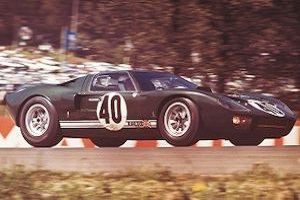In 1962, Henry Ford 2 began negotiations to buy Ferrari, in order to sprinkle some much-needed racing stardust on the increasingly dull company his grandfather had founded in 1903.

Ford GT40 1964
- YEAR REVEALED 1964
- PLACE OF ORIGIN Slough, Berkshire, UK
- HISTORICAL STATUS sports-racer/production car
- ENGINE V8-cylinder, 288ci (4,727cc)
- MAXIMUM POWER 335bhp (Mk3 road car), 485bhp+ in race tune
- LAYOUT mid-mounted engine driving the rear wheels
- BODYWORK two-seater coupé
- TOP SPEED 200mph+ (322kph+)
- NUMBER BUILT 107
Victory in the Le Mans 24-hour race was the main aim. Why Enzo Ferrari recoiled at the eleventh hour is still unclear, but Ford decided to beat Ferrari at his own game. Coincidentally, British racing car constructor Lola had just completed a mid-engined Mk6 GT car using a Ford V8 engine that showed enormous promise.
An opportune Ford bought the project and engaged Lola founder Eric Broadley to develop it. Ford’s involvement was often detrimental. It handled the styling, which wasn’t aerodynamic enough at race speeds. It also wanted the “GT40” to be factory-made, insisting on a cheap steel monocoque rather than Broadley’s aluminum “tub,” making it unnecessarily heavy.
At Le Mans in 1965, Ferrari won. A re-designed Ford GT40 then won Le Mans four times between 1966 and 1969. The first victory in the hands of New Zealanders Bruce McLaren and Chris Amon also saw the Ford GT40 become the first car to cover 3,000 miles (4,828km) in the race.
By 1967, Ford withdrew from racing, but a private team took two other Le Mans wins with the GT40. In 1969, Jacky Ickx beat Hans Herrmann’s Porsche by 328ft (100 meters)-the closest to a photo-finish the race has seen. The Mk3 was solely for road use, but of the 107 built, just 31 were road cars.